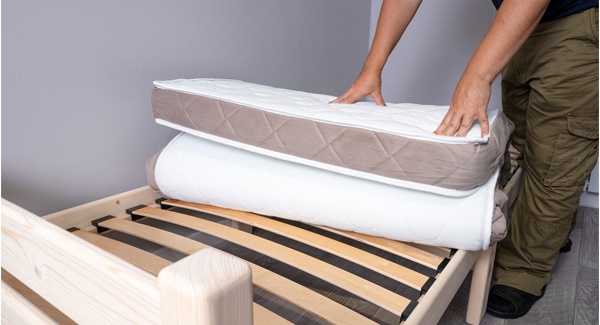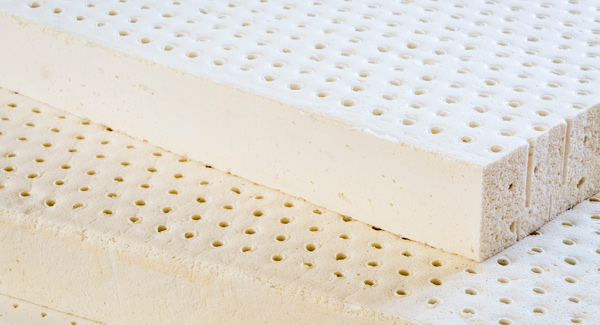Home » Mattress types » How Long Does A Tempurpedic Mattress Last?
How long does a Tempurpedic mattress last?
Article navigation
- Published:
- Written by: Tony Brown
- Topic: Mattress types
The Tempur material is the original memory foam, first developed at NASA to relieve the pressure experienced by astronauts during lift-off. Due to its unique pressure-relieving qualities, it was later adapted to mattresses and is now found in millions of homes worldwide.
While there are many memory foam mattresses to choose from, Tempur mattresses stand out due to their comfort, support and unique pressure relieving qualities.
However, while good quality sleep is something we should all be investing in, Tempur mattresses are expensive. So, if you’re considering investing in a Tempur mattress, it helps to know how long it may last.
A Tempur mattress should last between 10 and 15 years. Some Tempur mattresses may last longer or need replacing sooner. The lifespan of a Tempur mattress depends on its usage and how it has been looked after. Tempur mattresses are backed by a 10-year manufacturer guarantee against both materials and faulty workmanship. However, this guarantee does not extend to everyday wear and tear.
What factors affect how long a Tempur mattress lasts?
Several factors determine how long a Tempur mattress will last.
Body weight and size
A person’s body weight and size will likely affect how long a Tempur mattress will last. A heavier person will put more stress and strain on the mattress, and visible signs of wear and tear may be noticeable sooner.
Mattress selection can also affect its lifespan. Tempur mattresses are available in various depths and firmness. Typically, the deeper the mattress, the more supportive and comfortable it should be. A heavier person may find a firmer Tempur mattress more supportive. A softer mattress may cause the body to sag and put excessive strain on the mattress.
Likewise, a thinner Tempur mattress may not provide sufficient support for a heavier person and cause the mattress to wear out faster.
Care and maintenance
Some basic care and maintenance will help ensure a Tempur mattress lasts for as long as possible. This includes airing the mattress each morning, rotating it from time to time, using protective covers and following the manufacturer’s care advice.
How to extend the life of a Tempur mattress
There are several ways to keep a Tempur mattress in good condition and help extend its life.
Ensure the Tempur material does not get wet
You should never allow a Tempur mattress to get wet as this can damage the material. Avoid sponging or soaking the foam material with water or cleaning fluids, as doing so can damage the material and invalidate the guarantee.
When taking a shower or bath at night, do not allow wet hair to come into contact with the mattress.
You should also avoid using a hot water bottle, as any leaks may result in the mattress getting wet or stained. This can cause significant damage to the material and again invalidate its guarantee.
Use a mattress protector
Using a mattress protector will help protect the mattress against stains, spillages and accidents. It can also help avoid mattress discolouration and staining and prevent liquids from soaking into the Tempur material.
The mattress protector should be breathable, absorbent and water-resistant. You should avoid using a thick mattress protector. This can create a barrier between you and the Tempur material, which may affect the feel and performance of the mattress.
Another option is to use a mattress topper, which provides an extra comfort layer and keeps the mattress in good condition.
Avoid jumping on the mattress
As tempting as it may be, do not allow children to jump up and down on the mattress as this can damage the material.
Clean the covers regularly
Most Tempur mattresses come with removable, washable covers to help keep the mattress clean.
Each night, these covers accumulate body moisture, dirt, sweat, body oils, dust mites and dead skin cells. So washing the covers creates a healthy and hygienic environment while helping to keep the mattress fresh and allergy-free.
When cleaning the covers, always follow the manufacturer’s instructions which are usually found on the label stitched inside the cover.
Rotate the mattress
Tempur mattresses are non-turn. They only have one sleeping surface and cannot be flipped over. They can be occasionally rotated from head to toe. Doing so will help even out the wear and extend the life of the mattress. Avoid bending or folding the mattress when turning.
Ensure a Tempur mattress is paired with a suitable bed base
A Tempur mattress should always be placed on a well-ventilated bed base that allows good air circulation to prevent moisture build-up. The mattress must also be placed on an even surface. If the base is uneven or shows visible signs of sagging, the mattress will simply conform to its shape.
Tempur mattresses can perform well on slatted bed frames with plenty of air circulation underneath. It is recommended that the slats are no more than 90mm apart. Otherwise, the material may sag between the slats. The mattresses tend not to perform as well on sprung bed bases, as this can cause some people to sink too much into the mattress, making it difficult to turn over in bed.
You should avoid using a valance on the bed base as this can restrict airflow. Many modern bed bases are available in a selection of fabrics and colours, so there is no need to use a valance in any case.
Never place a Tempur mattress on an old worn-out bed base. Not only can this affect how the mattress performs, but it can also reduce its life and invalidate the manufacturer’s guarantee.
Do not use an electric blanket
Tempur does not recommend the use of electric blankets with its mattresses. This is because the material responds best to natural body heat. Placing an electric blanket directly on the material may soften the mattress and damage the foam over time.
Signs that a Tempur mattress may need replacing
Over time, all mattresses will begin to deteriorate. Once this happens, the mattress is unlikely to provide sufficient support.
The mattress is sagging
The Tempur material has good recovery properties, meaning that it can retain its shape over longer periods. Over time, the material may not recover, and the sleeping surface may become lumpy and sag.
A sagging mattress can put the body out of natural alignment, which can cause aches and pains. So when you notice permanent indentations in the mattress, it is best to replace it as soon as possible.
An old mattress may contribute to poor sleep
When an old mattress is past its best, it can often contribute to poor sleep. An old mattress may feel uncomfortable. You may toss and turn more during the night and wake up feeling sore and with aches and pains. This is usually a sign that the mattress has reached the end of its natural lifespan.
An old mattress may trigger allergies
Over its lifespan, a mattress collects dust, dirt, debris, bacteria, sweat, bodily oils and maybe even stains and spillages from food and drink. All of which can trigger allergies. Replacing a mattress every few years creates a clean and healthy sleeping environment.
Will a Tempur mattress outlast an ordinary memory foam mattress?
Comparing a Tempur mattress with ordinary memory foam can be misleading. Many manufacturers will claim that their memory foam products will perform as well and even outlast a Tempur mattress. This is not necessarily the case.
While some people may believe that memory foam mattresses are more or less the same, the differences are often vast, which is usually reflected in their price and longevity.
Many manufacturers buy materials, such as foam, from suppliers overseas. As there is no industry standard, manufacturers do not have to specify the depth, density or quality of memory foam used in their mattresses. This often results in the memory foam breaking down much sooner than expected. With correct care, an ordinary memory foam mattress may last up to 8 years, depending on the quality of its materials and how it is used and looked after.
A Tempur mattress will typically outlast other memory foam mattresses. They come with a 10-year guarantee and can last between 10 and 15 years. Some Tempur mattresses have even been known to last around 25 years. So the price you pay for a Tempur mattress is often reflected in how long it lasts.
Final thoughts
A Tempur mattress is a significant investment, but the Tempur material continues to outperform and outlast other memory foam mattresses.
Share this article

About the author
Tony Brown is the founder and creator of The Bed Consultant. His career in the bed industry began in 2002. After graduating from university with a degree in Business Administration, Tony joined one of the largest independent furniture retailers in the UK as a bed consultant. Tony has helped thousands of customers find the perfect mattress.





